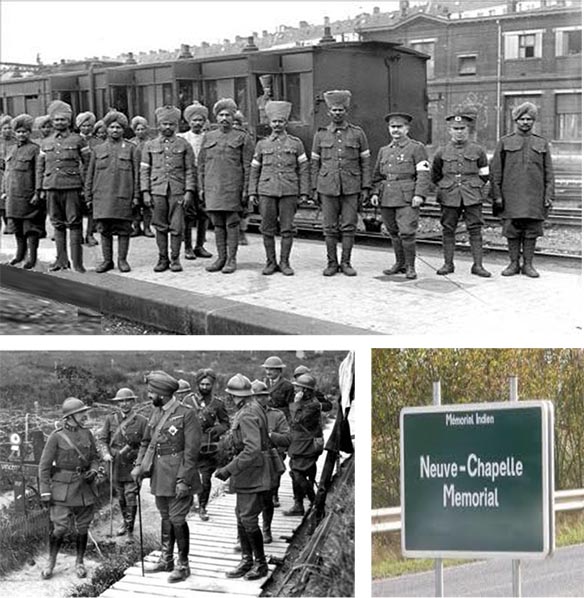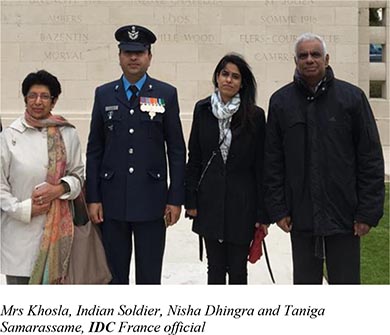Honouring Indian Soldiers who served in World War 1
FRANCE and INDIA – FREEDOM and LIBERTY by Ragini Arasen
Around 1.3 million soldiers from India participated in World War I (1914-1918). Among them, 140,000 Indian soldiers were sent to France. They were Sikhs, Punjabis and Gurkhas who came to strengthen the British army to defend freedom and liberty in France against invasion. They were soldiers from different ethnic, linguistic and religious backgrounds. The Indians troops were mobilized on August 8, 1914 at the request of London without even getting any approval from the parliament of New Delhi. At that time, India was under British rule.
The Indian soldiers left the port of Bombay and landed at Marseille in France on September 26, 1914. They were immediately sent on the North front so as to help the French and Belgian soldiers to fight against the Germans. They were dressed in simple light cottons uniforms, which were far too light to face the extreme winter of North of France. They were having frozen feet, pneumonia and life in the muddy trenches was very hard to bear for the Indians who were not used to this climate. In 1914 and 1915, the Indian soldiers were engaged in the various fights. At Neuve Chapelle, Lavantie and Givenchy, they helped in the British offensive against the Germans. The Indian troops suffered a lot and only during that period 4047 Indians were recorded in the British casualty sheet. This tragedy and sacrifice of these soldiers is well related in a film “Farewell My Indian Soldier“of an Indian filmmaker and novelist based in Paris, Vijay Singh. The soldiers wrote about their experiences in around 600 letters when they were in hospitals, records of which are maintained in the Haryana Academy of Art and Culture. “Soldiers used to send one rupee from their monthly salary to the academy, which went towards education of students,” says the filmmaker.
As World War I was coming to its end, the Indian soldiers participated in the procession of the Bastille Day on July 14, 1916 in Paris.
On October 07, 1927, The Memorial of Neuve Chapelle was inaugurated in the presence of Marshal Ferdinand Foch to honor the memory of Indian soldiers who died in France during World War I. On a wall, 4847 names of the soldiers are engraved, in alphabetical order and by combat unit. In the center of the memorial, one can read “In honor of the Indian Army who fought in France and Belgium, 1914-1918, and to perpetuate the memory of the soldiers whose names are engraved here.”
On April 11, 2015, Indian Prime Minister Shri Narendra Modi was the first and only Indian Prime Minister to have travelled to the memorial of Neuve-Chapelle to pay tribute to the 10 000 brave Indian soldiers who died during the First World War and who never returned back to their home. “I am honoured to pay homage to the Indian soldiers here at the Indian Memorial at Neuve Chappelle. Our soldiers who fought in foreign lands in the Great War, have won the admiration of the world for dedication, loyalty, courage and sacrifice. I salute them. ” said PM Modi.
The Ambassador of India, his Excellency Mohan Kwatra and the sous-prefet paying tribute to Chunki Soren, an Indian soldier of the 34th Division who died on 10 September 1917. Many of the Indian soldiers who fell 100 years ago in the WWI remain missing. Every time, one of their bodies is found on the French soil, then a ceremony is organized to pay military tribute to him.
On the November 12, 2017, members of the Indian Diaspora Council International (IDC) France under the leadership of Mr Taniga Samarassame attended a wreath laying ceremony at Neuve Chapelle and to pay homage to 2 Indian Soldiers whose bodies were found after 100 years. The soldiers belonged to the Garhwal Rifles regiment of the Himalayan region. This regiment lost nearly 700 soldiers during World War I.
World War I (1914-1918) ended at 11 a.m. on 11 November 1918 with the signing of the armistice between the Allies and Germany. It established the reputation of Indian soldiers for their bravery, courage and sacrifice.




